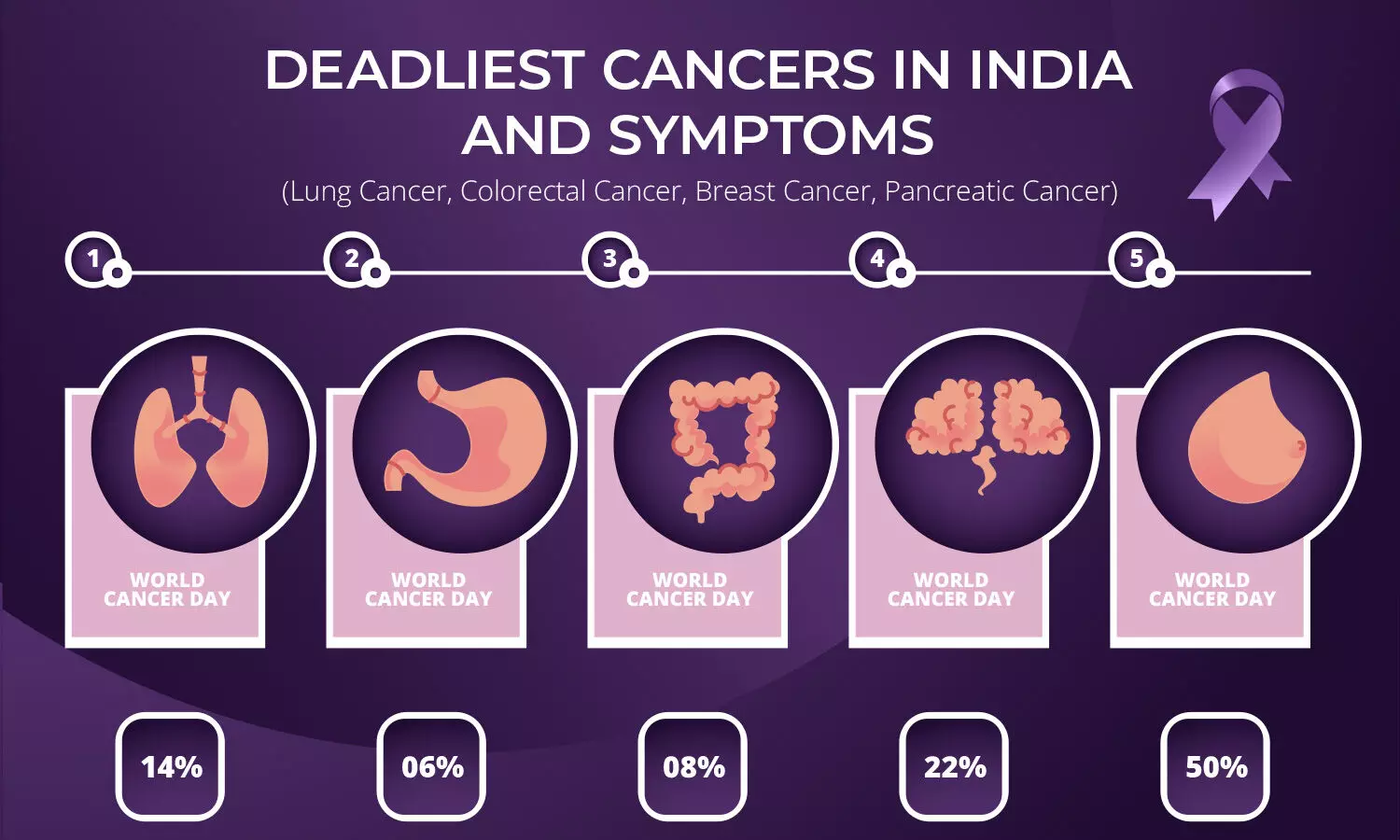Deadliest cancers in India and symptoms: Impact of deadliest cancers on public health in India

According to oncologists, the top four deadliest cancers in India are lung cancer and colorectal cancer. Lung cancer is also considered one of the deadliest cancers in the world
''When it rains, let's look for rainbows. When it's dark, let's look for stars. It may be hard to find a silver lining during a cancer diagnosis, but it's there. If we look for it, we will find it. Cancer is a word, not a sentence. Cancer is not a death sentence. It's just one word in our sentence, one part of our life.''
We are composed of trillions of cells, which typically proliferate and divide as necessary throughout our lifetime. Cells that are aberrant or have aged typically perish. Cancer develops when an error occurs during this process, causing the cells to continue producing new cells while abnormal or aged ones fail to undergo programmed cell death. The uncontrolled proliferation of cancer cells has the potential to displace healthy cells. This situation disrupts the proper functioning of our body.
The prevalence of cancer has been on the rise worldwide and in India, and one major contributor to this trend is people's increasingly unhealthy way of living. According to a report by the World Health Organisation (WHO), 1 out of 10 Indians will get cancer at some point in their lives, and 1 out of 15 will lose their battle with the disease. Obesity, smoking, drinking, and lack of exercise are some of the causes of the alarming increase in cancer rates in India. Data from India's cancer registry suggests that the country sees an estimated 800,000 new cases of cancer per year, with a threefold increase to 240,000 cases possible. Quite a few cancers are preventable. In this article, we will discuss the most deadly cancers in India, the mortality rates of major cancers in the Indian population, expert advice on recognizing deadly cancers in India, and the symptoms described by oncologists in the lead-up to World Cancer Day 2024 on February 4, which is observed annually to bring attention to various forms of cancer.
Facts regarding the top 4 lethal cancers and their warning signs:
Lung Cancer
Lung cancer originates in pulmonary tissues, specifically in the lining cells of the airways. Small cell lung cancer and non-small cell lung cancer are the two primary types. Diagnosing these types requires examining the cells under a microscope.
Lung cancer is most frequently caused by cigarette use. Additional tobacco use (e.g., pipe smoking or cigar smoking), secondhand smoke inhalation, occupational or domestic exposure to substances like radon or asbestos, the presence of specific gene mutations (abnormal alterations that occur during cell division), or a familial predisposition to lung cancer are all potential causes of lung cancer. Lung cancer can develop in individuals who have never smoked or have consumed less than 100 cigarettes in their lifetime.
The key facts concerning lung cancer:
Symptoms:
Coughing that persists or worsens over time.
A chest ache.
The sensation of being short of breath.
Wheezing.
Vomiting blood.
Feeling extremely exhausted at all times.
Loss of weight without a distinct cause.
Lung cancer is the primary cause of cancer-associated fatalities on a global scale and in India, with the highest male and female mortality rates.
Lung cancer is predominantly caused by smoking, accounting for an estimated 85 percent of all reported cases.
Lung cancer is frequently detected in its advanced stages when therapeutic alternatives are restricted.
Individuals at high risk could potentially be screened for, which would enable early detection and substantially increase survival rates.
By reducing exposure to environmental risk factors and tobacco control, primary prevention can decrease the incidence of lung cancer and save lives.
Colorectal Cancer
Colorectal cancer originates in either the rectum or the colon. These malignancies may also be referred to as rectal cancer or colon cancer, contingent upon their site of origin. Rectal cancer and colon cancer are frequently grouped together due to their many shared characteristics.
Although the exact aetiology of colorectal cancer remains unknown, specific risk factors—diet, tobacco use, heavy alcohol consumption, and smoking—are strongly associated with an increased likelihood of developing the disease. Additionally, individuals who have a family history of colorectal cancer or specific hereditary cancer syndromes are at an increased risk of developing the condition.
The key facts concerning colorectal cancer:
Symptoms:
A variation in bowel movements.
Constipation, diarrhea, or the sensation that the bowel is not emptying entirely.
Extremely dark or bright red blood in the bowel.
Stools that appear abnormally narrow or thin.
Abdominal discomfort characterised by recurrent gas pains, bloating, fullness, and cramps.
Colorectal cancer ranks as the second most prevalent cancer globally and in India, causing around 10% of all cancer cases and constituting the third most frequent cause of cancer-related fatalities.
The condition primarily impacts the elderly, as the majority of reported cases are observed in individuals 50 years of age and older.
A sedentary lifestyle, obesity, smoking, excessive alcohol consumption, high consumption of processed meats, and low consumption of fruits and vegetables are all lifestyle factors that contribute to the development of colorectal cancer.
Frequently, colorectal cancer is identified in its advanced stages when therapeutic alternatives are restricted.
Significant reductions in the incidence and consequences are achievable through the adoption of primary prevention strategies, including the maintenance of a healthy lifestyle, avoidance of risk factors, and early detection via screening.
Breast Cancer
A disease in which cells in the breast proliferate uncontrollably is known as breast cancer. Breast cancer manifests in various subtypes. The classification of breast cancer is determined by which breast cells undergo carcinogenesis. A majority of breast cancers originate in the lobules or ducts. Blood vessels and lymph vessels are pathways by which breast cancer can metastasize beyond the breast. Metastasis refers to the process by which breast cancer cells invade and populate distant anatomical sites.
Scientists have identified hormonal, environmental, and lifestyle factors as potential breast cancer risk factors. However, it remains unknown why some individuals without risk factors develop cancer while others with risk factors never do. A complex interaction between our genetic makeup and environment is probably the cause of breast cancer.
The key facts concerning breast cancer:
Symptoms:
A recently developed mass in the breast or underarm.
Inflammation or thickening of a portion of the breast.
Dimpling or irritation of the breast skin.
Rash or flaking skin in the vicinity of the nipple or breast.
Nipple pulling in or discomfort in the region of the nipple.
Breast cancer causes approximately 685,000 deaths globally and is the third most prominent cancer in India.
Roughly half of all breast cancers occur in women with no specific risk factors other than sex and age.
Approximately 15% of women diagnosed have a family history of breast cancer. Those with a first-degree relative (mother, sister, daughter) with breast cancer are nearly twice as likely to develop breast cancer themselves.
Approximately 0.5–1% of breast cancers occur in men.
When caught in its earliest, localized stages, the 5-year relative survival rate is 99%.
Pancreatic Cancer
Pancreatic cancer develops when pancreatic cells undergo mutation and proliferate uncontrollably, culminating in the development of a tumour.
The majority of pancreatic cancers originate in the ducts. Imaging tests fail to detect early-stage pancreatic tumours. The exact cause of pancreatic cancer remains unknown. Some factors have been identified by physicians as potential risk factors for this type of cancer. These include a family history of pancreatic cancer and smoking.
The key facts concerning pancreatic cancer:
Symptoms:
Jaundice.
Urine with a dark colour.
Light-colored feces.
Pain in the upper abdominal region.
Middle back pain.
Weakness and fatigue.
Itchy skin.
Nausea and vomiting.
Mortality associated with pancreatic cancer is the highest among all major cancers. Currently, it ranks third among cancer-related fatalities in the world and fourth in India, following lung and colon cancers.
The overall 5-year relative survival rate is 13% across all stages. A mere 15% of individuals receive a local disease diagnosis; consequently, their 5-year survival rate stands at a mere 44%.
A delayed diagnosis is a significant issue. Metastatic-stage pancreatic cancer is identified in approximately 80% of patients, and curative surgery is no longer a viable option.
Among the 21 most prevalent cancers, this represents the most unfavourable survival outcome.
Unexpectedly, it can typically manifest in individuals with no familial history of the ailment.
The Indian Cancer Society is dedicated to the advancement of diagnostic guidelines for deadly cancers in India, comprehensive understanding, therapy, and rehabilitation via its "Rise Against Cancer" initiative. Cancer support groups, rehabilitation for survivors, a cancer awareness registry, early detection screening, financial assistance for treatment, support group participation, and research and education comprise the entirety of the organization's endeavours.
Let's spread the word, love, and extend our help to those waging a war against cancer!














